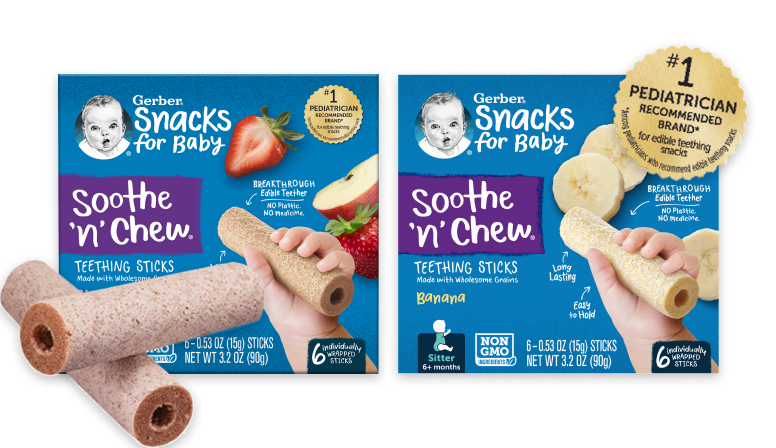Edible Teethers for Infants
Teething and the discomfort associated with teething is a natural step in child development. Gerber is the only brand with a full line of edible teethers in a variety of shapes and textures – including the breakthrough Soothe 'n' Chew® Teething Stick – the number one pediatrician recommended brand for edible teething snacks* (*among pediatricians who recommend edible teethers).


Soothe 'n' Chew®
Sitter: 6+ months
Edible, long lasting teething sticks designed to be easy for your little one to hold.
- Hard texture to be firm and long lasting
- Easy shape for baby to grasp or parent to help hold
- Made with wholesome grains
- Made with real fruits
- No artificial colors or flavors
When parents are looking for firm, hard, long-lasting texture for baby.
Soothe 'n' Chew® teethers were designed to retain a stick shape and firm texture during use to soothe teething gums. The Soothe ‘n’ Chew® teethers soften slowly to be long lasting.
- Soothing teething gums
- Satisfies urge to gnaw
- Develops hand to mouth coordination

Gentle Teething Wafers
7+ months
Each wafer is flavored with real juice, fruits, or veggies for your little one. The easy-to-grip design encourages self-feeding and helps soothe teething gums.
- Texture that dissolves easily
- Perfect shape for baby’s grasp
- No artificial flavors, colors, or sweeteners
- Mildly flavored with real fruits, juice, and veggies
When parents are looking to soothe teething gums with a texture that dissolves easily.
- Soothing teething gums
- Self-feeding confidence
- New tastes and textures

Teether Wheels
Crawler: 10+ months
Teether Wheels are a firm snack that softens into small flat pieces for baby to chew. The large shape is perfect for babies to hold, grasp and mash.
- The wheel softens but still gives a tasty crunchy texture at first, softens more slowly than wafers but more quickly than Soothe 'n' Chew®.
- Easy for your little one to grasp and hold
- The shape helps develop grip
- 2g of whole grains per serving
- No artificial flavors, colors, or sweeteners
When baby is ready for a smaller shape with a firm texture that softens while baby eats it.
- Soothing teething gums
- Self-feeding confidence
- New tastes and textures
Patient Resources and Practice Tools
Related Research and References
American Academy of Pediatrics
American Academy of Pediatric Dentistry
Food and Drug Administration
Safely Soothing Teething Pain and Sensory Needs in Babies and Older Children
Answers to Top Parent Questions
How to safely use edible teethers?
- As with all foods and eating occasions, infants using edible teethers should be seated in a highchair and closely supervised
- Make sure parents and caregivers follow package instructions for safe use.
How to take care of baby’s new teeth?
- Wipe gums twice a day with a soft, clean cloth in the morning after the first feeding and right before bed to wipe away bacteria and sugars that can cause cavities.
- When teeth come in, start brushing twice a day with a soft, small bristled toothbrush and plain water.
- Visit the dentist by your baby’s first birthday to spot signs of problems early.
- Talk to your dentist or doctor about putting fluoride varnish on your child’s teeth as soon as the first tooth appears.
- Examples of key behaviors that place a child at high risk for caries include continual bottle/sippy cup use (with fluids other than water), sleeping with a bottle (with fluids other than water), frequent between-meal snacks of sugars/cooked starch/ sugared beverages, and frequent intake of sugared medications.
For more information visit: https://www.cdc.gov/oralhealth/basics/childrens-oral-health/index.html
Can parents/caregivers freeze or refrigerate the Gerber Soothe ‘n’ Chew® teething stick?
Do not refrigerate or freeze.
When will baby start teething?
- Teething generally starts around 4-7 months, but discomfort from teething could start as early as 3 months.
- Most babies will develop teeth between 6-12 months and have all their baby teeth by 3 years.
- The timing of teething varies widely and is also determined by hereditary factors too.
What’s going on during teething?
The upper or lower two front teeth (central incisors) will usually appear first, followed by the opposite front teeth. The first molars appear next, followed by the canine or eyeteeth.

What are the signs baby is teething?
Around 3 months of age, infants start to explore the world around them with their mouth, and begin to put their hands in their mouth. You should expect drooling, as well as them having a desire to chew on something hard, which is soothing. Remember, every baby is different, so some children might have no problems! And edible teethers are only for infants older than 6 months. Follow package instructions.
Normal teething behaviors
- Fussiness
- Trouble sleeping
- Irritability
- Loss of appetite
- Drooling more than usual
Abnormal teething behaviors
- Fever
- Diarrhea
- Rash






